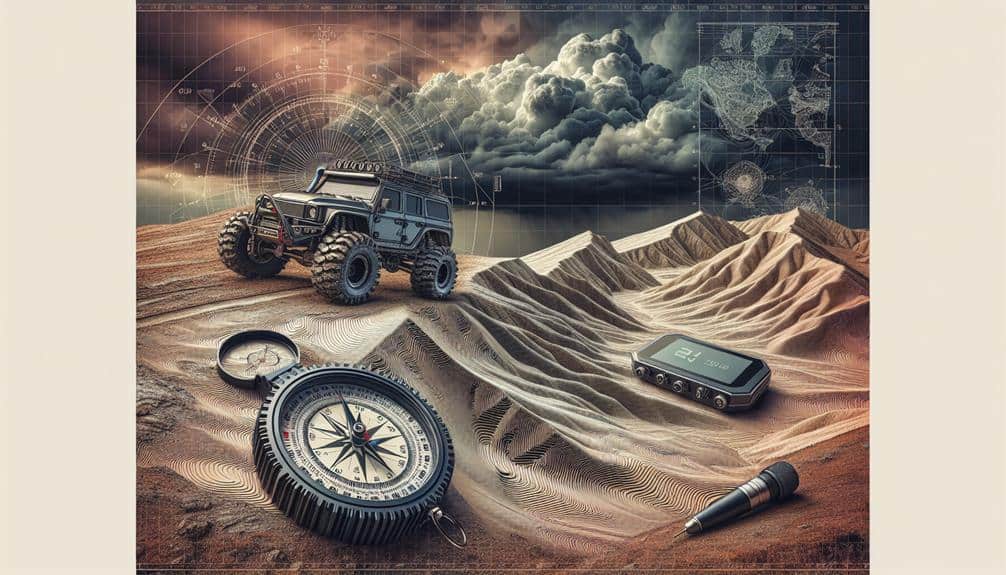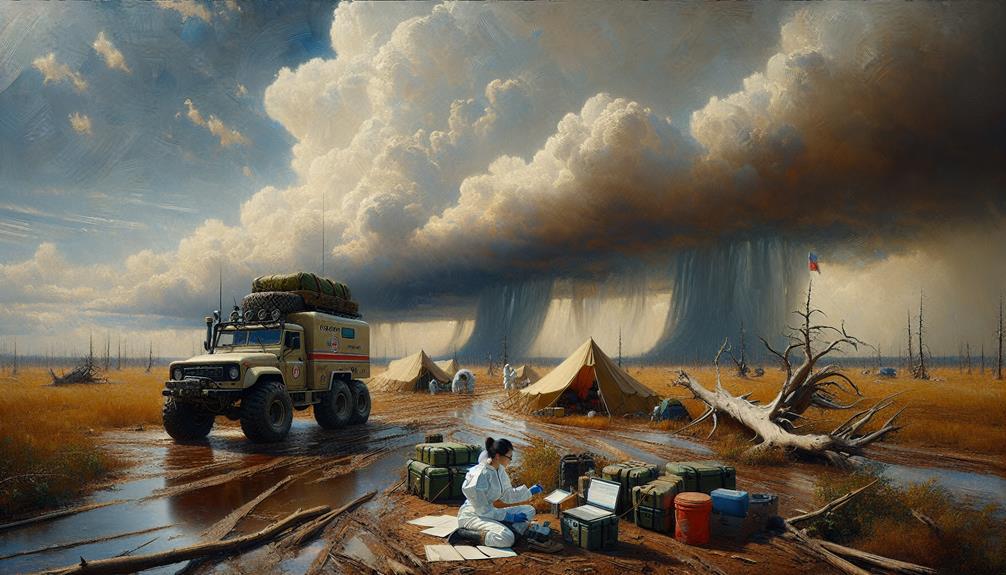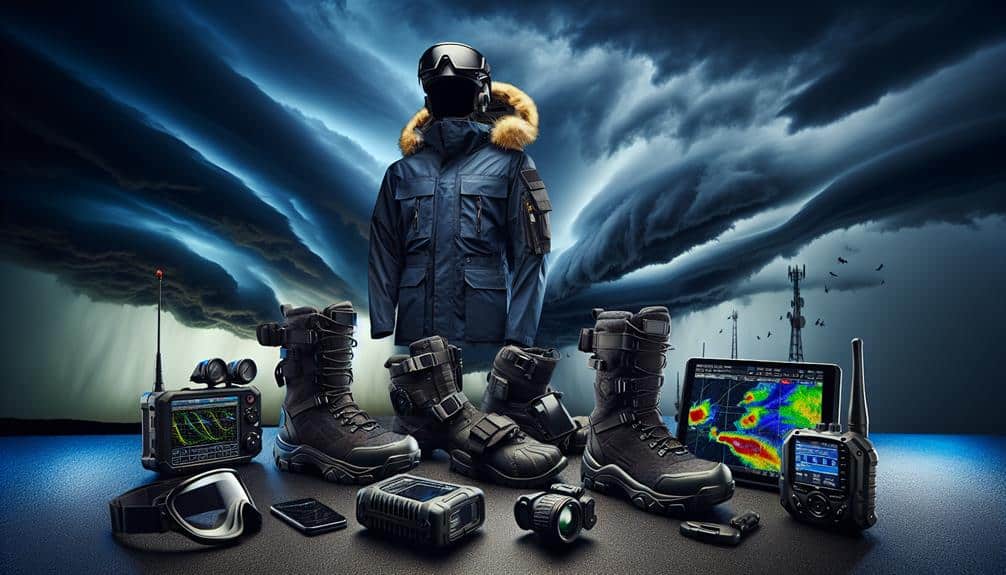As storm chasers in isolated regions, we must analyze meteorological data, including Doppler radar, and prepare sturdy emergency supplies. Our vehicles need weather-resistant gear, and reliable communication tools like satellite phones and emergency beacons are crucial. For weather monitoring, we employ Doppler radar, anemometers, and barometers. Resilient, portable shelters and pre-mapped evacuation routes are non-negotiable. Health and safety readiness requires specialized first aid kits and protocols for heatstroke and hypothermia prevention. Post-storm, we evaluate damage and coordinate with local authorities. By following these guidelines, we ensure mission success and safety. To master these guidelines, explore further insights and technical details.
Key Points
- Utilize signal boosters and satellite phones for reliable communication in remote areas.
- Prepare emergency supplies, including first aid kits, non-perishable food, water, and weather-resistant gear.
- Monitor weather using Doppler radar, anemometers, barometers, and satellite tracking for real-time data.
- Choose durable, weather-resistant shelter materials and identify natural barriers for protection.
Pre-Storm Preparation
Before we head out, we carefully analyze meteorological data to identify potential storm development zones. We examine satellite imagery, Doppler radar data, and surface observation reports to forecast the storm's trajectory and intensity. This thorough assessment enables us to anticipate the most likely locations for storm genesis and movement, optimizing our chances for successful observation.
Equally important to our mission is the preparation of emergency supplies. We stock our vehicles with essential items: first aid kits, non-perishable food, water, flashlights, and spare batteries. Each item is selected based on its usefulness during prolonged field operations. We make sure our vehicles are equipped with sturdy, weather-resistant gear to withstand the harsh conditions we may encounter.
Mapping out evacuation routes is another key aspect of our pre-storm preparation. Using topographic maps and GPS technology, we identify multiple exit paths from potential storm zones. This redundancy is vital for ensuring our safety in case of unexpected road closures or changes in storm behavior. By planning these routes in advance, we maintain the flexibility to adapt quickly, guaranteeing our safety while maximizing our storm-chasing efficiency.
Our thorough pre-storm preparation forms the foundation for both successful and secure storm-chasing endeavors.
Reliable Communication Tools
Reliable communication tools are indispensable for coordinating our team and maximizing real-time data sharing during storm-chasing missions. We rely on signal boosters to amplify weak cellular signals in isolated regions, enabling us to maintain strong communication channels.
Satellite phones are another critical asset, providing dependable connectivity where traditional networks fail. In addition to these, emergency beacons are essential for our safety. These devices transmit distress signals, allowing rescue teams to locate us quickly in case of emergencies.
Coupled with weather radios, which continuously broadcast crucial updates from the National Weather Service, we stay informed about rapidly changing weather conditions.
For peak performance, we must test our equipment regularly. Signal boosters should be calibrated to optimize range, and satellite phones need regular firmware updates to ensure compatibility with global networks.
Emergency beacons must have fully charged batteries and be checked for functionality before each mission. Weather radios should be programmed with the latest frequencies to guarantee timely alerts.
Weather Monitoring Techniques
To effectively monitor weather conditions, we employ an array of sophisticated instruments including Doppler radar, anemometers, and barometers. Doppler radar is vital for tracking storm movements, detecting wind patterns, and identifying potential tornado formations. By measuring the velocity of precipitation particles, Doppler radar provides real-time data that's essential for making split-second decisions.
Anemometers measure wind speed and direction, offering important insights into the storm's intensity and trajectory. Paired with barometers, which track atmospheric pressure changes, these instruments allow us to predict weather shifts with high accuracy. Rapid pressure drops often signal the approach of severe weather, enabling us to act swiftly.
Satellite tracking enhances our capabilities by delivering high-resolution images and data from space. This bird's-eye view is invaluable for identifying large-scale weather patterns and tracking storm systems across vast, isolated regions. Combining satellite data with ground-based radar monitoring ensures a thorough understanding of the storm's behavior.
Incorporating these technologies enables us to stay one step ahead of the storm. We can navigate safely, gather essential data, and experience the raw power of nature while maintaining our freedom to explore isolated regions. Accurate weather monitoring is the cornerstone of successful storm chasing.
Emergency Shelter Options
When considering emergency shelter options, we must evaluate temporary shelter materials, identify safe locations, and utilize emergency shelter kits. Each option requires specific criteria to guarantee maximum safety and efficiency during severe weather events.
Temporary Shelter Materials
In the unpredictable environments we often face, selecting the right temporary shelter materials is essential for ensuring safety and endurance. When evaluating shelter materials, we must consider both durability and functionality.
High-quality, weather-resistant fabrics like ripstop nylon or polyester are indispensable due to their capacity to withstand strong winds and heavy rain. Moreover, these materials often feature UV resistance, extending their longevity in prolonged sun exposure.
Portable structures are our go-to when we need mobility without compromising on protection. Pop-up tents with integrated aluminum or fiberglass poles provide a lightweight yet robust framework. Their ease of assembly is critical when time is of the essence. Additionally, insulation becomes a key factor, especially in extreme temperatures.
Multi-layered tents with reflective liners can notably reduce heat loss, while ventilated designs prevent condensation build-up, ensuring a dry interior.
Data from field tests indicate that shelters combining these elements can endure wind speeds up to 60 mph and temperatures ranging from -20°F to 120°F. By prioritizing shelter materials with proven durability and opting for portable structures with effective insulation, we can maintain our operational freedom while maximizing safety and comfort during our storm-chasing endeavors.
Identifying Safe Locations
When evaluating potential emergency shelter options, we must prioritize locations that offer natural barriers against wind and debris while ensuring accessibility and stability. Our location scouting should focus on areas with terrain features like hills, rock formations, or dense forests that can act as windbreaks. These natural shelters are essential for reducing the risk of injury from flying debris.
For safe routes, mapping out potential evacuation paths that are clear of obstacles and provide quick access to these natural shelters is necessary. Using topographical maps and GPS data, we can identify the most efficient routes, ensuring minimal exposure time to storm hazards.
In our evacuation planning, establishing multiple emergency contacts who can provide real-time updates on weather conditions and route viability is crucial. This network enhances our situational awareness, allowing us to adapt our plans as conditions change.
We must also consider the structural integrity of man-made shelters like abandoned buildings or barns. These should be evaluated for their ability to withstand high winds and offer protection from falling objects.
Emergency Shelter Kits
Equipping ourselves with complete emergency shelter kits is necessary for securing our safety during storm-chasing expeditions in isolated regions. Our kits should include high-quality, durable materials for shelter building, such as tarps, stakes, and ropes. These items allow us to construct temporary shelters quickly, providing protection from severe weather conditions. When selecting tarps, opt for those with reinforced grommets and tear-resistant fabric to withstand high winds and heavy rain.
In addition to shelter-building materials, our kits must contain extensive survival equipment. A multi-tool with functions like cutting, digging, and fastening is invaluable. We should also include lightweight, compact sleeping bags rated for extreme temperatures, and emergency blankets to prevent hypothermia. Data from the National Weather Service suggests that temperatures can drop rapidly during storms, making thermal insulation important.
Furthermore, water purification tablets and portable stoves are essential for maintaining hydration and nutrition if we're stranded. A NOAA weather radio with an integrated flashlight and USB charger ensures we stay informed and our devices powered.

Accurate navigation and mapping are essential for storm chasers to safely track and study severe weather phenomena in isolated regions. We rely heavily on GPS tracking for real-time positional data, ensuring we maintain precise awareness of our location relative to storm systems.
High-resolution topographic maps are indispensable tools, providing detailed terrain profiles that help us anticipate geographical challenges and optimize our routes.
By integrating GPS tracking with digital topographic maps, we can overlay storm data, enabling advanced analysis of storm paths and potential impact zones. This synergy enhances our decision-making, allowing us to adapt quickly to changing weather conditions while avoiding natural obstacles such as rivers, mountains, and unpaved roads.
Furthermore, we use Geographic Information Systems (GIS) to compile and interpret spatial data, facilitating complex mapping tasks and improving our predictive capabilities. GIS technology allows us to visualize weather patterns in relation to the landscape, offering a detailed understanding of the environment we operate in.
Health and First Aid
As storm chasers in remote areas, we must prioritize our health and first aid readiness. We should make sure our emergency medical supplies checklist is thorough and up-to-date.
Additionally, understanding the protocols for heatstroke and hypothermia prevention, as well as mastering CPR and basic first aid, is crucial for our safety.
Emergency Medical Supplies Checklist
In preparing for storm chasing in isolated regions, a thorough emergency medical supplies checklist is necessary to guarantee prompt and effective first aid response. First aid training is paramount for ensuring we can handle various medical emergencies. Equipped with the right knowledge, we can efficiently address injuries and prevent complications.
Our medical supplies should include a complete first aid kit. Key items for wound care must include sterile gauze pads, adhesive bandages, antiseptic wipes, and medical tape. We can't overlook the importance of having a tourniquet and hemostatic agents for severe bleeding control. Additionally, we need to stock up on pain relievers, antihistamines, and anti-inflammatory medications.
Having an emergency response plan is essential. We should carry a CPR mask and an automated external defibrillator (AED) for cardiac emergencies. A digital thermometer, tweezers, and a pair of trauma shears should also be part of our kit. Don't forget to include a flashlight and extra batteries for low-light situations.
It's vital to regularly check and update our medical supplies, ensuring nothing is expired or damaged. Being prepared with the right tools and training empowers us to stay safe and effective in the face of unpredictable weather challenges.
Heatstroke and Hypothermia Prevention
Preventing heatstroke and hypothermia requires us to monitor our body's temperature and environmental conditions meticulously, ensuring we take proactive measures for both cooling and warming as needed.
Hydration management is essential; we need to drink water regularly, even if we don't feel thirsty, as dehydration accelerates the risk of heatstroke. Electrolyte solutions can also help maintain our body's fluid balance.
For sun protection, wearing broad-brimmed hats, UV-blocking sunglasses, and applying high-SPF sunscreen is non-negotiable. Lightweight, moisture-wicking clothing layers can help regulate our body temperature by allowing sweat to evaporate efficiently.
In cold conditions, layering is important. We should wear moisture-wicking base layers, insulating middle layers, and waterproof outer layers to prevent hypothermia. Emergency blankets can be lifesavers, reflecting up to 90% of body heat and providing a compact, lightweight solution for unexpected temperature drops.
Data shows that proper hydration and appropriate clothing layers significantly reduce the incidence of heatstroke and hypothermia among outdoor adventurers. By integrating these measures into our routine, we enhance our safety and freedom to explore isolated regions without compromising our health.
Let's stay vigilant and prepared, ensuring we can chase storms safely and effectively.
CPR and Basic First Aid
Equally important to our safety in isolated regions is knowing how to administer CPR and basic first aid, as these skills can be life-saving in emergencies. When we're far from medical facilities, immediate injury response becomes critical. Obtaining first aid training and CPR certification equips us with the knowledge to handle medical emergencies effectively.
First, let's talk about CPR. When someone experiences cardiac arrest, every minute counts. Performing chest compressions at a rate of 100-120 per minute and delivering rescue breaths can double or triple their chances of survival. We should practice these techniques regularly to make sure we're prepared.
Basic first aid is equally crucial. We need to know how to treat burns, cuts, fractures, and other injuries common in storm-chasing scenarios. For example, applying pressure to a bleeding wound or immobilizing a fractured limb can prevent further damage until professional help arrives.
Carrying a well-stocked first aid kit is a must.
Post-Storm Procedures

Once the storm has passed, we promptly initiate a thorough damage evaluation to document the impact and gather key data. Our first task is to conduct a systematic survey of affected areas, using GPS coordinates to map destruction and photograph key damage points. This data is essential for informing post-storm cleanup efforts and coordinating community support initiatives. We collaborate with local authorities to guarantee accurate reporting and resource allocation.
Next, we engage in post-storm cleanup activities. We clear debris, evaluate structural integrity of buildings, and assist in restoring essential services—power, water, and communication networks. Our technical skills in evaluating infrastructure are pivotal in expediting community recovery. Simultaneously, we gather meteorological data to refine predictive models for future storms.
Addressing mental health is another crucial component. Exposure to severe weather events can result in significant psychological trauma. We work with trauma assistance teams to provide immediate emotional support and refer individuals to long-term mental health services. This dual approach ensures both physical and emotional recovery.
Frequently Asked Questions
What Types of Clothing and Gear Are Best for Storm Chasing?
For storm chasing, we'll need durable footwear choices and dependable rain gear. Our camera equipment should be weather-resistant, and drone usage enhances data collection. Prioritizing functional, protective clothing guarantees safety and freedom while capturing critical storm data.
How Can I Safely Photograph or Film a Storm?
To safely photograph or film a storm, we must prioritize safety precautions and equipment. We should monitor weather conditions, select secure locations, and use sturdy tripods, waterproof gear, and remote controls to avoid exposure during extreme conditions.
Are There Any Legal Restrictions or Permits Required for Storm Chasing?
We should examine local permit requirements and legal restrictions before storm chasing. While regulations vary, certain areas may mandate permits. Staying informed guarantees compliance and avoids penalties, allowing us to chase storms freely and safely.
What Wildlife Hazards Should I Be Aware of in Isolated Regions?
In remote locations, we must anticipate animal encounters and implement safety precautions. Frequent wildlife includes snakes and large mammals. Our emergency plans should include first aid kits and communication devices to guarantee rapid response to incidents.
How Can I Maintain Vehicle Safety and Readiness During Storm Chasing?
'An ounce of prevention is worth a pound of cure. We regularly inspect our vehicle's fluids and tire pressure, confirm emergency shelters are mapped out, and verify communication options work efficiently to maintain vehicle safety and readiness.'


